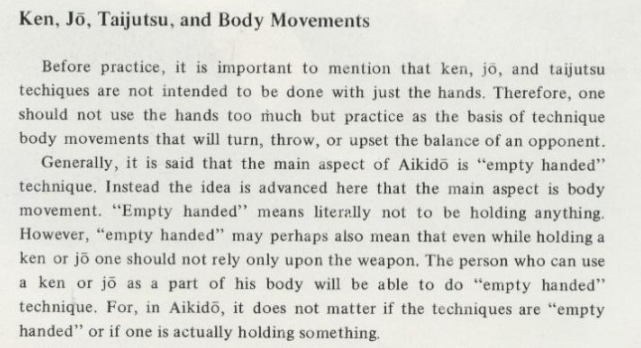Taijutsu & Bukiwaza
The traditional Aikido training consists of Taijutsu (empty hand techniques) and Bukiwaza (weapon techniques).
The basic training includes a real attack of a partner, a technique always follows the attack. This is the first step on your way. Each lesson starts with tai no henko and morote dori kokyunage exercising. Within these two techniques you can learn how to turn round, keep the balance and harmonize your movements. Then the following techniques can be taught.
At Kokoro Kai Iwama Ryu dojo we put an emphasis on the connection between empty hand and weapon techniques. Empty hand techniques are derived from sword techniques. Bokuto (a wooden sword), jo (a stick) and tanto (a knife) are used in Iwama ryu. Weapon techniques help to develop stronger constitution and improve such skills as a better Ma-ai (fight distance) estimation and a firm poise.
What is Bukiwaza?
Let’s first clarify this distinction. In Aikido, taijutsu means “body techniques”, and refers to the practice of empty-hand techniques that do not involve the use of weapons. Bukiwaza means “weapon techniques” and refers to the practice of Aikido using weapons such as bokuto (wooden sword) and jo (wooden staff). For the purpose of our discussion, we regard the practice of weapon-taking, bukidori, as part of taijutsu.
Though we often see O'Sensei wielding a bokuto or a jo in extant movies and photographs, it is widely recognized that his student of 23 years in Iwama, Saito Morihiro Shihan, was the key proponent of Aiki Ken and Aiki Jo, the two components of bukiwaza. Saito Shihan organized bukiwaza into six types of practices:
Tanren
Spirit forging practice such as tanren uchi, which consists of striking with a suburito against a hard object. A similar practice existed with the jo.
Suburi
Simple moves with the ken (7 ken suburi) or the jo (20 jo suburi)
Kata
Series of moves with the jo stringed together (13-jo kata and 31-jo kata)
Awase
Paired practice consisting of simple moves with the ken or jo
Kumi
Paired practice consisting of complex moves with the ken (kumitachi) or jo (kumijo), or both (kentaijo).
Henka and Riai
Variations of the above, and correlations between bukiwaza and taijutsu.
We should note at this point that there are related arts involving the use of ken (e.g. iaido) and jo (e.g. jodo) that are part of Budo (Japanese martial arts) but are essentially different from Aiki Ken and Aiki Jo in several respects. For our purpose here, suffice it to point out that the key difference is that, in Aiki Ken and Aiki Jo, the weapons serve the body, whereas in the other arts the weapons take precedence and the users have to adapt their bodies to maximize the effectiveness of the weapons.
Aiki Ken and Aiki Jo are especially created to support taijutsu and are not intended to be intrinsic arts in themselves. Therefore, no comparison should be made with these other systems of training involving blades or staff.
Saito Shihan considered Aiki Ken and Aiki Jo an integral practice of Aikido and went as far as creating an instructor certification program to protect and preserve the critical components of bukiwaza. In order to determine how much bukiwaza to practice, we must first understand how it affects our practice of Aikido.
Why Bukiwaza?
There should be no question as to the significance of bukiwaza in Aikido training. One just needs to glean from all the available pictures of O'Sensei holding a bokuto or a jo to realize that it was an important aspect of his Aikido training. The practical question that arises often is not whether, but how much bukiwaza: how many hours a week should be devoted to bukiwaza, versus taijutsu?
There are six observable aspects of bukiwaza training that enhance taijutsu and make it an integral part of Aikido training.
Reinforce the foundational stances
Aiki Ken is based on the hanmi stance and Aiki Jo is based on the hito emi stance. These two stances form the foundations of Aikido techniques. Continued practice of Aiki Ken and Aiki Jo reinforces these stances by constantly putting them to the test. Without a solid stance, the ken or jo technique would fail, whereas this is not so obvious in taijutsu.
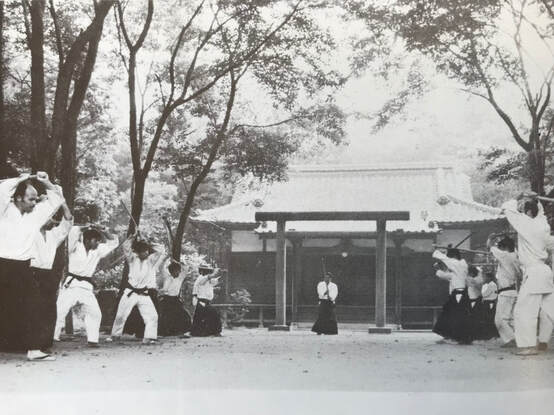
Enhance precision of movement
When using the ken and the jo we treat them as extensions of the body, thus the effect of our hip movements is enlarged and errors and inaccuracies are easier to spot and fix. The ease of correction contributes to increased precision.
Promote extension of Ki
The use of a ken or jo requires constant extension of consciousness and ki (energy) through the weapon, either extending downward when striking with a ken or extending forward when thrusting with a jo. This sustained effort to extend energy creates pathways of energy that help students maintain ki extension in empty-hands techniques.
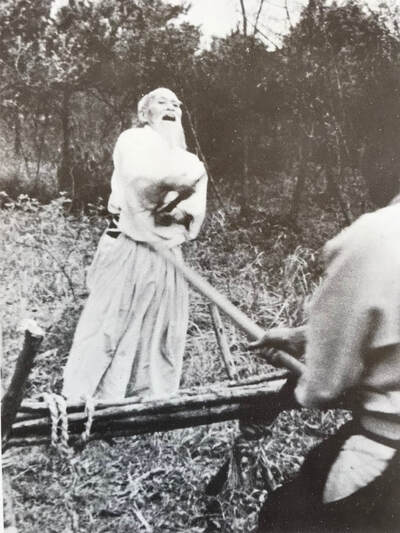
Reinforce alignment and connection of energies
To execute Aiki Ken and Aiki Jo properly we need to continually check the alignment of the weapon with our body center; and the alignment of our center, weapon and partner’s center. This practice ingrains the feeling of alignment and connection between our center and the partner’s center in the long run and transfers it into taijutsu.
Promote body integration
In Aikido, we hold the ken and jo with two hands, creating a merging of ki from both sides of the body that is directed toward the target. The two sides of the body bolster each other and work in tandem, such that even when the weapons are not used, as in taijutsu, the feeling of oneness and circularity between right and left persists.
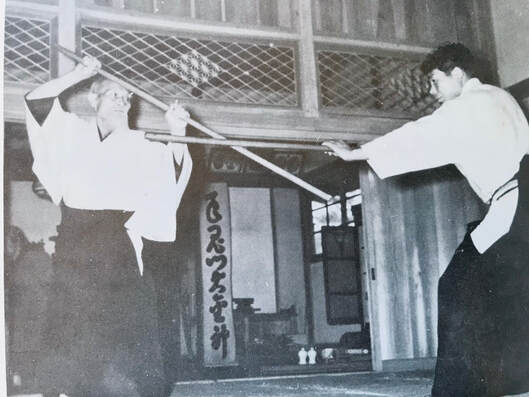
Encourage alertness
Use of hard weapons in practice increases the risk of injury through accidents. A simple error in timing or angle may result in a severe bruise. The higher risk encourages the students to be more alert during practice and this awareness is often carried over into taijutsu.
"Blend with your partners’ movements by matching and mirroring the speed and timing of the attack"
O'Sensei
Kumitachi
The kumitachi came originally from an old sword school. They were modified to include the concept of Aiki by the O'Sensei, who left them as a legacy. There are many possible variations of the kumitachi. The Founder, when he taught, called these first attack and second attack variations. These variations are naturally used with the ken but are soon adapted to taijutsu. Consequently, the kumitachi are considered to be the personality of ken, jo, and taijutsu basic techniques. If one does not have a good understanding of suburi, it will be useless to practice the kumitachi. If practice is done everyday on the kumitachi and partner practices, stability of the hips will not be attained, and an important point of practice will be missed. Therefore, begin each practice session with the seven suburi.
Uchitachi (Attacker) and Uketachi (Defender)
The kumitachi are not to be considered competition. They are practices, and the partners do not vie for an attacking or superior position. It was said that one should be uchitachi for 10 years before being allowed to become uketachi. It was felt that this was the proper way to learn.
"Weapons’ training in Aikido allows us to practice the principles in a clearer, more isolated way because you are unhampered by egotistical battles of strength."
O'Sensei
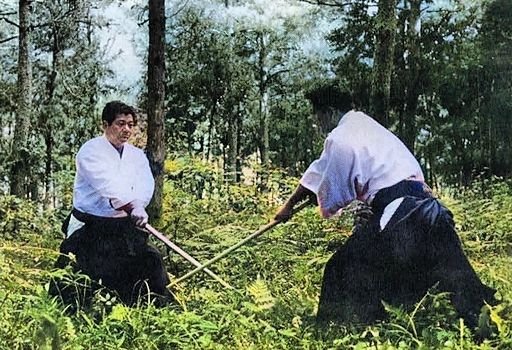
Bukiwaza Alone is Not Aikido
As explained above, bukiwaza is important to Aikido practice; it complements Aikido taijutsu but does not represent Aikido. Bukiwaza serves Aikido similar to how the suburi helps to strengthen the kumitachi. The benefits of bukiwaza practice are reflected in the quality of taijutsu. Bukiwaza is not an intrinsic end product in itself; in other words, we do not become sword or jo experts as a result of training in Aiki Ken and Aiki Jo.
We should recognize this subordinate relationship to correctly assess the need for bukiwaza within an Aikido training program.
Let’s also make it clear that an overemphasis on bukiwaza can be detrimental to a seito’s training, mostly due to its lack of human physical contact. We train on the mat to get feedback from our partners as to where our center is and hence, find out who we are. This feedback is initially physical and results from the constant interaction of bodies on the mat. Therefore, when we remove the physical contact, or replace it with a bridge that involves wooden weapons, we diminish the amount and quality of the feedback.
Only those experts who have mastered their energy bodies would benefit from an interaction of the energetic bodies during bukiwaza training, with minimum taijutsu training.
On page 14 of Traditional Aikido Vol 2 by Morihiro Saito Shian, it says:
